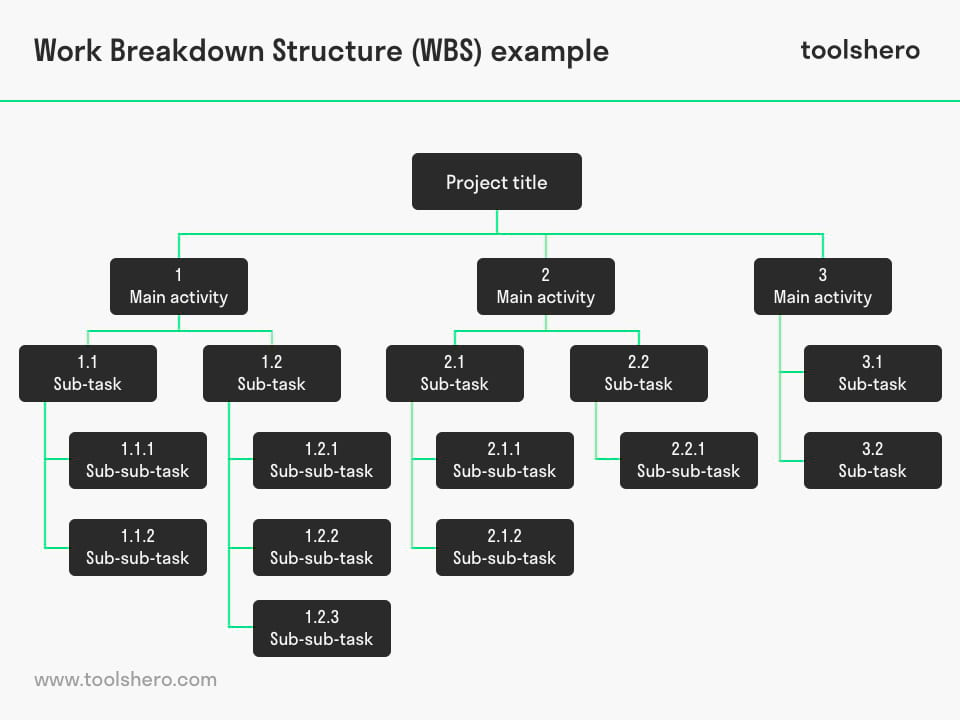Work Breakdown Structure (WBS)

Work Breakdown Structure (WBS): this article explains the WBS or Work Breakdown Structure in a practical way. After reading it, you will understand the basics of this powerful project management tool. This article also contains a downloadable and editable work breakdown structure template. Enjoy reading!
What is a Work Breakdown Structure?
Work Breakdown Structures (WBS) is a term that is used in project management. A WBS has a hierarchical structure in which concrete, main activities are divided into logical sub-activities.
Often, a WBS has a graphical design so that it is clear to everyone in a project what has already been done and what sub-activities should still be done to bring the project to a successful conclusion.

Figure 1 – an example of a Work Breakdown Structure (WBS)
Work Breakdown Structure (WBS) : Top down and Bottom up
Often, planning software can help to create and display the sub-activities that lead to the main activity and the final outcome of the project. The hierarchical structure ensures an orderly overview of necessary activities. There are two different approaches.
Top-down approach
When you work with an already created project plan, the main activities are already known. By subdividing each main activity into detailed sub-activities and re-splitting them into smaller sub-activities (sub-sub activities), a hierarchical tree structure is created, which is typical for a WBS. The foundation starts at the top and branches down into smaller, sub-tasks.
Bottom-up approach
If there is no clear project plan yet, it is also possible to start from the bottom and figure out what activities should be carried out.
To discover that, it is good to brainstorm about it with all the stakeholder. After such a session, the activities that are related can be grouped together. This foundation can also lead to a hierarchical tree structure, that branches out upwards into various sub-activities.
Goal of WBS
The goal of a Work Breakdown Structure is to clarify the division of tasks and the accompanying responsibilities. In addition, it gives a good overview of the scheduling of each individual activity and the total duration of the project.
In addition to defining and organising the sub-tasks within a project, WBS has several more advantages. The overview makes it clear who is in the highest level of the WBS. This level is responsible for the total project budget.
In addition, the various department budgets for the sub-activities can now be easily calculated. That way, WBS allows not only for a good cost indication, but also for a good indication of the time that would be needed for the various components of the project.
Hierarchy
A WBS is an important project tool that contributes to the objectives of a team within a project, in manageable sub-tasks. The hierarchical structure is the most eye-catching feature of a WBS.
In addition, it is characterised by the visual appearance, making it immediately clear to a project team what contribution is expected from them during the project. Each level of the WBS provides detailed information about the corresponding sub-tasks.
But how are those sub-tasks included in the WBS? The project team needs to provide input. The team contributes to the WBS, by identifying crucial, functional sub-activities that are necessary in order to complete the main activity.
By further dividing these sub-activities in sub-sub-activities, no phase can be skipped and everyone knows what is expected of him/her. These sub-sub-activities are linked to the individual employees and function as their assignment within the project. On this operational level, the specific work packages are identified and grouped. The work packages represent the to-do list that the employee needs to complete within a certain amount of time.
From the costs perspective, it is sensible to group these work packages and assign them to a specific department. By calculating the various department costs within the entire project, the organisation can track the financial progress as well as the project performance.
WBS focus areas
To give the application of a WBS the best chance at success, it is good to keep the following points in mind:
- From a hierarchical starting point, the highest level proposes the final project;
- Sub-sub-activities include work packages that are specifically meant for a department within an organisation;
- Sub-activities and sub-sub-activities definitely do not need to be defined at the same level within the WBS;
- The (sub) list of tasks defines the tasks, duration and costs;
- A (sub) list of tasks should take a maximum of 10 working days;
- A (sub) list of tasks is not dependent on other (sub) lists of tasks;
- Each (sub) list of tasks is unique and should not be copied within the WBS.
Potential risks of a Work Breakdown Structure
A Work Breakdown Structure of a project can also be used to identify potential risks within a project. A sub-activity that is not properly defined, can provide a definition risk. These risks need to be revised as the project progresses. By integrating the WBS in the organisational structure, it is easier for the project manager to plan moments where such risks can be identified.
Also when a project is behind schedule, it is possible to look at the WBS to see which sub-activities are the cause of this delay and quick adjustment can be implemented.
By working with colour codes, the status of each (sub)sub-tasks will be clear to everyone right away. This is comparable to the so-called Kanban system.
For example, the colour red is for ‘late delivery’, blue for ‘delivered on time’, yellow for ‘sub-task at risk’ and green for ‘properly completed’. These colours are an effective way to map the progress of a project and draw attention to possible problem areas of the WBS.
Work Breakdown Structure / WBS template
Start describing the different aspects of a Work Breakdown Structure with this ready to use work breakdown structure template.
Download the Work Breakdown Structure template
This template is exclusively for our paying Toolshero members. Click here to see if a membership is something for you!It’s Your Turn
What do you think? Is a WBS applicable in your daily work? Do you recognize the practical explanation or do you have more suggestions? What are your success factors for clarifying the division of tasks and the accompanying responsibilities?
Share your experience and knowledge in the comments box below.
More information
- Brotherton, S. A., Fried, R. T., & Norman, E. S. (2008). Applying the work breakdown structure to the project management lifecycle. In PMI Global Congress Proceedings (pp. 1-15).
- Golany, B., & Shtub, A. (2001). Work Breakdown Structure. Handb. Ind. Eng. Technol. Oper. Manag, 3, 1263-1280.
- Lanford, H. W., & McCann, T. M. (1983). Effective planning and control of large projects—Using work breakdown structure. Long Range Planning, 16(2), 38-50.
- Lavold, G. D. (1988). Developing and using the work breakdown structure. Project Management Handbook, Second Edition, 302-323.
How to cite this article:
Mulder, P. (2017). Work Breakdown Structure (WBS). Retrieved [insert date] from Toolshero: https://www.toolshero.com/project-management/wbs-work-breakdown-structure/
Original publication date: 07/11/2017 | Last update: 08/22/2023
Add a link to this page on your website:
<a href=”https://www.toolshero.com/project-management/wbs-work-breakdown-structure/”>Toolshero: Work Breakdown Structure (WBS)</a>












